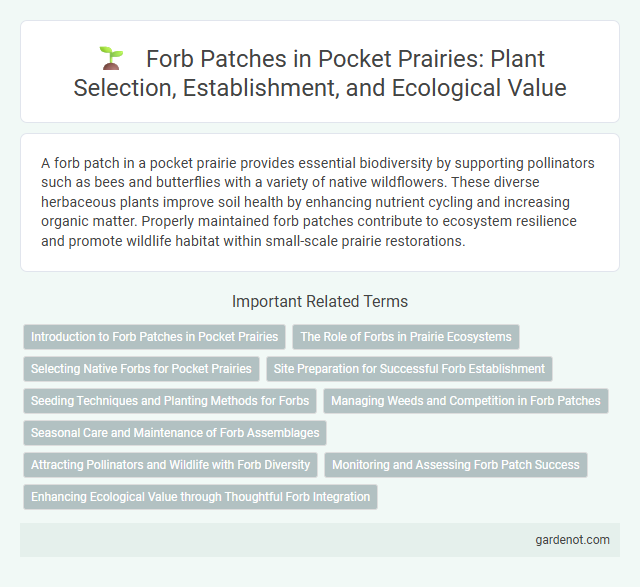A forb patch in a pocket prairie provides essential biodiversity by supporting pollinators such as bees and butterflies with a variety of native wildflowers. These diverse herbaceous plants improve soil health by enhancing nutrient cycling and increasing organic matter. Properly maintained forb patches contribute to ecosystem resilience and promote wildlife habitat within small-scale prairie restorations.
Introduction to Forb Patches in Pocket Prairies
Forb patches in pocket prairies consist of diverse herbaceous flowering plants that enhance biodiversity and provide critical habitat for pollinators. These patches improve soil health through deep root systems that promote aeration and nutrient cycling. Integrating forb patches into pocket prairies boosts ecosystem resilience and supports native wildlife populations.
The Role of Forbs in Prairie Ecosystems
Forb patches play a crucial role in prairie ecosystems by enhancing biodiversity and providing essential habitats for pollinators such as bees and butterflies. These herbaceous flowering plants improve soil health through nitrogen fixation and create microenvironments that support a wide array of wildlife. Forbs contribute to nutrient cycling and increase resilience against invasive species, maintaining the ecological balance of pocket prairies.
Selecting Native Forbs for Pocket Prairies
Selecting native forbs for pocket prairies enhances biodiversity by supporting local pollinators and wildlife. Prioritize species adapted to regional soil and climate conditions, such as Echinacea purpurea, Rudbeckia hirta, and Asclepias tuberosa, which provide vital nectar and habitat resources. Incorporate a diverse mix of bloom times and structural forms to create resilient, ecologically balanced pocket prairie ecosystems.
Site Preparation for Successful Forb Establishment
Effective site preparation is crucial for successful forb establishment in pocket prairies, involving soil loosening to enhance root penetration and moisture retention. Removing existing vegetation and minimizing soil compaction creates optimal conditions for seed germination and growth. Incorporating organic matter and ensuring proper pH balance further supports healthy forb development and biodiversity.
Seeding Techniques and Planting Methods for Forbs
Effective seeding techniques for forb patches in pocket prairies include precision drilling and broadcast seeding, which ensure optimal seed placement and soil contact. Utilizing dormant seeding during late fall or early winter leverages natural stratification, enhancing germination rates of native forbs. Incorporating nurse crops or mulch can protect fragile forb seeds and improve moisture retention, promoting successful establishment.
Managing Weeds and Competition in Forb Patches
Effective management of weeds in forb patches involves regular monitoring and targeted removal to reduce competition for essential resources like nutrients, water, and sunlight. Utilizing mulching and selective herbicides can suppress invasive weed species without harming native forbs, promoting biodiversity and healthy growth. Implementing strategic planting and maintaining optimal spacing further minimizes weed encroachment, supporting a resilient and thriving pocket prairie ecosystem.
Seasonal Care and Maintenance of Forb Assemblages
Forb patches in pocket prairies require targeted seasonal care to ensure robust growth and biodiversity. Regular monitoring during spring and summer helps identify invasive species and supports timely mowing or selective weeding, which promotes native forb health and reduces competition. Fall and winter maintenance involves leaving plant debris intact to protect root systems and provide habitat for pollinators and beneficial insects.
Attracting Pollinators and Wildlife with Forb Diversity
Forb patches in pocket prairies significantly enhance pollinator attraction by offering a diverse array of nectar and pollen sources essential for bees, butterflies, and other beneficial insects. High forb diversity supports a wider range of wildlife, including native birds and small mammals, by providing varied habitat structures and food resources throughout the growing season. Incorporating multiple forb species with staggered bloom times maximizes ecosystem resilience and promotes sustained pollinator activity in restoration efforts.
Monitoring and Assessing Forb Patch Success
Regular monitoring of forb patches involves detailed assessments of plant species diversity, growth rates, and coverage within pocket prairies to evaluate ecological health and restoration success. Employing standardized vegetation surveys and photographic records enables identification of invasive species incursions and adaptive management of site conditions. Quantitative data on forb density and reproductive output provide critical indicators for long-term sustainability and biodiversity enhancement in prairie restoration projects.
Enhancing Ecological Value through Thoughtful Forb Integration
Forb patches significantly enhance pocket prairie ecosystems by increasing plant diversity and providing critical habitat for pollinators and beneficial insects. Thoughtful integration of native forb species promotes soil health through improved nutrient cycling and supports a balanced microhabitat. Strategic forb placement enhances ecological resilience, contributing to long-term sustainability in pocket prairie restoration projects.
Forb patch Infographic

 gardenot.com
gardenot.com